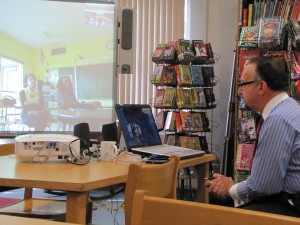Oysterponds mulls curriculum change

In response to declining numbers — a drop from about 100 to 83 students this year — and a desire to give its students the best education possible, Oysterponds is considering multi-age classrooms.
A group of about 20 Board of Education members, parents and teachers posed questions via Skype last Thursday morning to administrators and teachers at upstate Warwick Valley School District, where multi-age classrooms have been in use for 27 years through a system called Partners In Education (PIE).
One of Warwick Valley’s four elementary school offers the PIE multi-age program that places students in two different grades within one classroom. An advantage for Warwick Valley that Oysterponds wouldn’t have, because of its small size, is the freedom parents have to opt for general education rather than PIE.
If Oysterponds wwere to embrace the PIE system, it would be for all students, with no option for some to continue in a general education program they have now.
There’s a big difference between multi-age and multi-grade education, one of the Warwick Valley teachers advised the Oysterponds Skypers. The multi-age concept they practice does not simply place students who are in different grades together; it’s a creative and integrated approach to education, with curriculum developed largely by highly motivated individual teachers.
Parent involvement is critical to the concept — hence the name “Partners In Education” — with the recognition that not all parents have the same time to give to the program. But most can provide support one way or another.
Through the years, classroom sizes for PIE students in Warwick Valley have varied from 13 to 27 students, generally with a single teacher. But students receive a great deal of small group and individual attention; and older students have an opportunity to develop leadership skills as they assist younger students in learning, the Skypers were told. Not only does it give the younger students another voice in explaining lessons to them, but it provides the older students with a chance to master what they’ve learned by teaching it to others, according to the Warwick teachers.
The curriculum isn’t textbook-based. Through cooking, for example, students develop skills in reading, research, science, nutrition and math. They perform as well or better than general education students do on state tests, according to their teachers.
“It’s a lot of work” and teachers have to have “passion” for the program to yield good results, Warwick’s assistant superintendent for curriculum Dr. Marijane Reinhard said. Training teachers for the PIE program is better today than it was when they started 27 years ago and there are more materials available to PIE teachers. But still, when a PIE teacher leaves the program, finding a replacement is difficult, Dr. Reinhard said.
“It’s a constant struggle,” she said.
The few Oysterponds teachers who joined in for parts of the more than hour-and-a-half Skype session had questions about teacher prep time; whether extra compensation was available for the added time that PIE preparation requires; and how to balance special programs such as computer classes with the rest of a class program.
Several parents and board members, who stayed after the Skype session, expressed a mix of reactions, from concerns about losing their small classes to enthusiasm for PIE, generated largely by the passion the Warwick Valley teachers have for the program.
If PIE were to be implemented in Oysterponds, one parent suggested the school could become a magnet for other North Fork students who might want to participate, while general education students could go to another area school.
The next step in the district’s exploration is likely to be a visit to Warwick Valley by Superintendent Stuart Rachlin and some board members.








